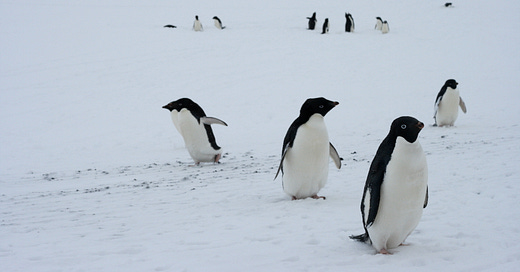How Penguin Poop Powers the Polar Atmosphere
A new study links penguin colonies to particle formation in the Antarctic atmosphere—revealing how guano shapes clouds and potentially, the climate.
Breaking the Ice:
A new study has unveiled a startling connection between penguin guano (excrement used as fertilizer) and atmospheric chemistry in Antarctica. Led by researchers from the University of Helsinki and Aerodyne Research, the paper reveals that penguin colonies are a significant—and previously underappreciated—source of ammonia, a critical ingredient in forming cloud condensation nuclei (CCN) in the region.
Using high-sensitivity instruments at Marambio Station on the Antarctic Peninsula, the team recorded elevated levels of ammonia—up to 13.5 parts per billion—when winds blew from nearby penguin colonies. This gaseous ammonia interacts with sulfur compounds from oceanic phytoplankton to kickstart the formation of new aerosol particles. The result? Clouds that might not otherwise form in the pristine, particle-starved skies above Antarctica.
Their findings suggest penguins don’t just waddle across icy landscapes—they help seed the very clouds overhead, revealing a profound link between biology and climate in Earth’s most remote environments.
Quick Melt:
The implications of this study stretch far beyond the shoreline of Seymour Island. In remote environments like Antarctica, cloud formation is constrained by a lack of aerosol particles—tiny seeds around which water vapor condenses. Clouds, in turn, play a powerful role in regulating Earth's radiation balance, making them a pivotal player in climate dynamics.
By pinpointing penguin guano as a potent source of ammonia, the researchers have shown that biological systems—particularly large bird colonies—can exert substantial influence over atmospheric processes. The study also observed the presence of dimethylamine (DMA), another compound likely originating from guano, which amplifies particle formation rates by up to 10,000 times when paired with sulfuric acid.
Notably, these biological emissions can persist even after penguins migrate, thanks to guano-enriched "ornithogenic" soils that continue to release ammonia. As Antarctic ecosystems are strained by rising temperatures and declining sea ice, changes in penguin populations could influence not just biodiversity, but cloud formation and regional climate feedback loops. This suggests a possible positive feedback mechanism: warming reduces penguin numbers, which in turn may suppress aerosol production and change cloud behavior, potentially accelerating local warming.
The Thaw:
Don’t Understand Biological Aerosols, Cloud Nucleation, and Feedback Loops? AccumulationZone Explains.
In clean, remote environments like Antarctica, gases such as sulfuric acid and ammonia are critical for nucleating tiny atmospheric clusters. These clusters can grow into aerosols, which then act as cloud condensation nuclei—tiny seeds around which water vapor condenses to form clouds.
Penguin colonies, it turns out, are hotspots for ammonia emissions. As the birds nest and defecate in concentrated areas, their guano accumulates in the surrounding soil. This ornithogenic soil continues to emit ammonia long after the penguins leave. During the austral summer, when photochemical activity is high and marine emissions of sulfur compounds like dimethyl sulfide (DMS) are abundant, this ammonia becomes especially potent.
When ammonia from penguins combines with sulfuric acid in the atmosphere—a product of DMS oxidation—it facilitates the growth of new particles. These particles can grow large enough to influence cloud formation, particularly in the low-aerosol environment typical of Antarctica. In essence, penguin colonies act as biological aerosol factories.
What’s more, the study detected the presence of dimethylamine (DMA), another nitrogen compound likely derived from guano. Though present in trace amounts, DMA plays an outsized role in stabilizing molecular clusters, increasing particle formation rates by up to 10,000 times. While DMA wasn’t directly quantified, its signal was observed in the chemical composition of growing particles, confirming its atmospheric relevance.
Climate change threatens penguin populations by melting sea ice, disrupting food webs, and degrading breeding grounds. A decline in penguins could reduce atmospheric ammonia, lowering particle concentrations and potentially suppressing cloud formation. Fewer clouds could mean more solar radiation reaches the surface—exacerbating regional warming. It's a vivid example of how tightly climate, chemistry, and ecology are intertwined.
Final Thoughts
From microscopic phytoplankton to penguin droppings, every layer of the Antarctic ecosystem plays a role in shaping our atmosphere. As we move further into the Anthropocene, understanding and preserving these biological-atmospheric links may be key not just to conserving wildlife, but to maintaining climate stability on a planetary scale.



Fascinating study, thanks for sharing it.